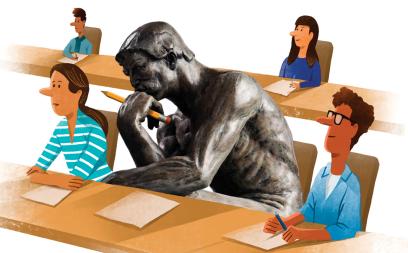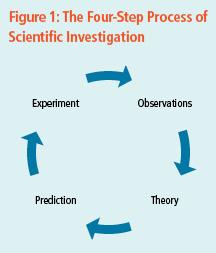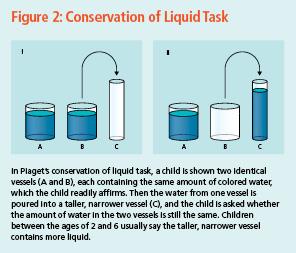Question: Is it useful for teachers to know the basic science of how children learn? I thought it was, but a professor in my teacher education program disagreed; what teachers need to know, she said, are research-based findings about what works in classrooms. She thought there’s not much point in learning abstract science that doesn’t directly apply to classrooms.
Answer: There’s no doubt that research bearing directly on classroom practice is crucial. But I respectfully disagree with your professor and maintain that it’s useful for educators also to know the basic science around children’s cognition, emotion, and motivation, because beliefs about what children are like inevitably influence your practice. Everyone has such beliefs; the purpose of learning the science would be to broaden and deepen that knowledge, and to disabuse you of any misconceptions you might have. Still, not everything of concern to scientists is valuable to educators.
Scientific knowledge can influence educational practice in more than one way. Sometimes the applications are overt, as when scientific descriptions of how children learn offer new ideas for instructional methods. For example, researchers have described the learning benefits of spacing out practice,1 and some educators have sought to incorporate that finding into their classrooms.
Science can also influence education through the use of scientific methods to evaluate the effectiveness of different educational practices. Scientists have a lot of experience designing experiments and can offer useful techniques to help decide whether, for example, two reading programs differ in how much they motivate children to read independently.
Both types of applications are overt and self-conscious. They are what researchers usually call “applied science.” That contrasts with “basic science,” research that is conducted not with the aim of improving education, but with the aim of providing a scientific description of the world. In this case, the basic science of concern tells us about how children learn, their emotional lives, and what motivates them. It’s a scientific view of what kids are like and how they develop. That basic scientific knowledge is the third avenue through which science can influence educational practice.
An educator’s practice is, of course, influenced by her beliefs about what children are like. Teachers try to tune their practice to what they believe to be children’s nature, in the perfectly reasonable belief that teaching will be more successful if it accounts for the way children learn. These beliefs influence not only planning but also teachers’ in-the-moment reactions and responses when something unexpected happens in the classroom. Furthermore, beliefs influence our receptiveness to new ideas.2 When a vendor offers a new product, for example, or an administrator suggests a new classroom practice, teachers evaluate it in light of their beliefs about children.
Scientific findings provide one (but obviously not the only) source of information contributing to educators’ beliefs about the nature of children. Researchers and practitioners have written about the scientific backing of these beliefs, typically when they think there’s widespread misinformation about the scientific credibility of some finding. For example, a number of articles have appeared in the last 10 years pointing out the frail scientific basis for learning styles.3*
Here I want to make a different point: some statements concerning children’s learning are perfectly sound scientifically but should not influence educational decisions. That includes some statements that seem like they ought to have a direct bearing on classrooms. In this article, I will describe three types of statements scientists make, only one of which ought to influence teaching practice. Even that type of statement, we’ll see, can be misapplied.
Three Types of Scientific Statements
To appreciate these three types of scientific statements and how they differ, we need a brief introduction to the scientific method. Again, we’re not talking about applied science, which sets a goal of changing something (in this case, improving education). Rather, we’re talking about the method of basic science, which sets the goal of describing something (in this case, how children think and learn, what motivates them, how they experience emotions, and so on). This research is mostly conducted by scientists who don’t think about education at all.
Basic science operates in a four-step cycle, as shown in Figure 1. First, a scientist gathers observations about the world. Next, the scientist attempts to summarize the observations with a small set of general statements—a theory. In the third step, the theory is used to generate predictions about phenomena that have not yet been observed. In the final step, the scientist conducts experiments to test the prediction. The result of the test constitutes a new observation about the world, and the cycle continues.
click image to enlarge
Consider psychologist Jean Piaget. He famously observed his own children at play to glean insights into their thinking.4 Based on those observations, he developed his theory of cognitive development, proposing that children move through a sequence of four stages, characterized by (among other things) increasing ability to use abstract thought. To test predictions of the theory, Piaget conducted experiments by asking children to perform carefully devised tasks. For example, in one task, children were to solve problems with a balance scale, using weights with differing characteristics.5
This brief summary of the scientific method illustrates two types of statements that are important to our purposes. First, there are observations of the world—for example, observing that children between 2 and 6 years old typically fail to understand that liquid does not change volume when it is poured into a differently shaped vessel (see Figure 2).
click image to enlarge
Psychologists are especially interested in observations that they see consistently, even if children vary in background and age, and even if they complete different tasks in different contexts. For example, the observation that task performance improves with practice seems so universally observed, we assume it must reflect a very deep truth about the nature of learning. I’ll call that type of observation an empirical generalization, and I will argue it’s especially useful to educators.
The second type of statement is theoretical. Theoretical statements are much more abstract and general than empirical observations. They are meant to summarize many existing empirical generalizations and can be used to predict what ought to happen in novel situations. For example, one feature of the second stage of development in Piaget’s theory of cognitive development is centration; children focus on just one characteristic of a complex situation. Centration captures the observation about liquid and volume: children conclude that a narrow vessel holds more liquid because they focus on just one feature of the liquid—its height in the vessel.
Scientists make a third type of statement—epistemic—that’s not captured in Figure 1, and indeed scientists only occasionally explicitly make this type of statement. Scientists inevitably make assumptions about the nature of whatever is under study. Piaget made assumptions about the nature of knowledge: What does it mean for the child to know something? Should we just say, as Piaget did, that the child has a “belief” about the amount of liquid in a vessel? Or perhaps we’re starting off wrong by assuming that we can talk about what the child knows independent of the social context in which the child does his thinking? Or perhaps we’d be better off creating a theory of brain states rather than of beliefs; after all, isn’t what we’re calling a belief really a product of the brain? Or maybe it’s a bad idea to talk about beliefs or brain states, given that we can’t adequately measure either one. Maybe we should focus on what the child does instead.
You can see that unless you make some assumptions, it’s impossible to create a theory or even to describe what you think you observe. Assumptions shape how you describe what you observe and what you think a theory ought to look like. In the case of the psychology of thought, these are epistemic assumptions, statements about the nature of thought and knowledge.
The distinctions among these three types of statements scientists make—empirical generalizations, theoretical statements, and epistemic assumptions—may sound a little esoteric, but they are important to educators. In considering whether scientific findings should influence their practice, they (appropriately) ask whether the science is sound, because sometimes it’s not. For example, many practitioners have been told for years that there is scientific proof that younger students can multitask effectively, but that’s not actually the case.6
The point of this article is that scientists make lots of statements that are scientifically sound, but even if the statement is scientifically sound, it’s not always useful to educators. Recognizing the distinctions among empirical observations, theoretical statements, and epistemic assumptions is crucial to understanding when and how scientific statements may be useful.
Empirical Generalizations
I suggest that empirical generalizations have the greatest potential to be useful to educators. These are observations of how children think or feel in particular circumstances that are consistent across tasks, age, contexts, and subject matter. Their power comes from the fact that they tell us what most kids are like most of the time. Although it’s natural for educators to be interested in how children differ (so as to be sure to meet the needs of each child), children actually have much in common.7 The basic architecture of the mind is not wildly different from child to child, and we can identify some of the consistencies regarding how attention is deployed, how learning operates, and so on. Indeed, over the years, these “Ask the Cognitive Scientist” columns in American Educator have emphasized such consistencies and what they might imply for the classroom (see the table here).
Empirical generalizations like those in the table allow educators to predict how children will likely respond in a particular situation, and use that information to shape their practice. That said, this application is not always straightforward.
Empirical generalizations don’t offer an infallible guide for what to do. There are two ways they might be mistakenly understood as prescriptive. First, empirical observations could be seen as laws that must not be violated. For example, research shows that when people are rewarded for a behavior, they may engage in the behavior to earn the reward, but their motivation may actually decrease once the rewards are discontinued.8 Yet, that shouldn’t be taken to mean that rewards are never useful or appropriate. A teacher may recognize the risk of a tangible reward and nevertheless decide it’s the right classroom decision for other reasons. For example, you may offer a small reward to prompt a decidedly nonreader to give a book a try, in the hopes that the student will be surprised by how much he or she likes the book after all.9 Empirical generalizations usually apply to one aspect of a complex situation, but educators must consider all aspects of the situation.
Second, many empirical generalizations concern student thought, not teaching behavior, and the way to prompt that student thought may not be obvious. Consider this empirical generalization: memory is more enduring when students think about the meaning of the content and relate it to things they already know.10 Fine, but what are you supposed to do to prompt this sort of mental activity in students? One possibility is to set tasks for students (e.g., answering questions or making comparisons) that can only be completed if they think about meaning. This sort of teaching is often called “active learning,” because students are, it appears, more actively engaged in the learning process, in contrast to when they simply listen to a lecture.
But it’s a mistake to equate activity we can see with mental activity. Students may be engaged in a hands-on activity that is rather mindless—for example, executing the steps listed in a biology lab without really thinking about them. And they may think deeply about the content of a carefully put together lecture, even if they appear to be merely sitting. This example offers another illustration of the possible misinterpretation of empirical generalizations. Sometimes they are generalizations of how students react to specific things teachers do, but other times they are generalizations about the consequences of particular mental activity on the part of the student. The two should not be confused.
Theoretical Statements
Theoretical statements would seem to be invaluable for practitioners. The purpose of a theory is to integrate and coordinate observations. So if, as I suggested in the previous section, empirical generalizations are valuable to educators, statements from theories should be still better: each summarizes many empirical generalizations.
That would be true if the purpose of a theory were indeed to integrate and coordinate empirical generalizations. That’s the way a practitioner would develop a theory of children’s learning, but that’s not the purpose to which scientists develop theories. As shown in Figure 1, a key purpose of theories in the scientific process is to generate new predictions. Those predictions will be tested in experiments that thereby create new observations, which are used to refine theories. So it’s not enough for a theory to integrate and coordinate existing empirical generalizations. For a scientist, a theory must offer predictions of new, yet-to-be-verified observations. If it doesn’t, science doesn’t move forward.
The fact that theories go beyond existing data has a couple of implications that make them counterproductive for practitioners to use.† First, it is inevitable that some novel predictions derived from a theory will be wrong. As I mentioned earlier, Piaget proposed a comprehensive and highly influential stage theory of cognitive development. Developmental stage theories hold that children’s thinking doesn’t change gradually but rather is stable for long periods of time and then rapidly reorganizes, which is the shift from one stage to another.
An educator seeking to put Piaget’s theory to use might draw the reasonable prediction that certain types of thought are simply beyond the cognitive abilities of some children—they haven’t reached the right stage of development yet. Offering that work to the child would be developmentally inappropriate. But research since Piaget’s death in 1980 indicates that development does not proceed in stages.11 That prediction was wrong.
A second, related problem is that theories have a shelf life. Science operates in a cycle, as shown in Figure 1, and as we make more and more observations of the world, it becomes more and more likely that our current theories will fail to account for all of them. Every scientist accepts that our best theories should be viewed as contingent; even remarkably successful theories like Isaac Newton’s law of universal gravitation eventually are shown to be wanting and are superseded.
Contemporary educational psychology textbooks often summarize influential theories like Piaget’s theory of cognitive development, Erik Erikson’s theory of personality development,12 Lawrence Kohlberg’s theory of moral development,13 and Lev Vygotsky’s theory of learning.14 But all of these theories are decades old, and the textbooks that present them always include several pages of explanation regarding ways in which the theories are known to be inadequate.
So when an educator’s practice is guided by the best-available scientific theory, that educator adopts some beliefs that will be proven wrong in time. The only questions are how many of the beliefs are wrong, and when will we know they are wrong. Empirical generalizations, in contrast, are not predictions but are summaries of things that scientists have observed. Theories will come and go, but the empirical generalizations that theories are meant to account for are much more likely to be seen as accurate decades later. For example, the last century has seen a lot of theories seeking to explain why practice helps memory, and few scientists are fully satisfied with any of them. But every scientist agrees that practice helps memory.
Epistemic Assumptions
Consider statements like “learning is social,” “everybody learns differently,” “knowledge is constructed,” and “learning is natural.” Each represents an assumption about the nature of learning or knowledge. These are not empirical generalizations or theoretical statements; they are more general, and they are not grounded in observations of the world—they are assumptions.
The generality of the statements is obvious when you consider the many ways they could play out in a theory. “Learning is social,” for example, might be taken to mean that our social environment provides learning opportunities—we can learn from our peers, and the characteristics of our peers determine what we learn. Or this statement might refer to something more profound, the assumption that our perception of the world is bound by our social group and our culture—what we learn depends on how we interpret our experiences, and that interpretation of events is shaped by our social environment. Or, it might imply an altogether different definition of learning. I may know very little about automobile repair, but if my wife does, then I have ready access to that knowledge. So don’t I, in a sense, “know” about automobile repair? Perhaps it’s a mistake to think of “knowledge” as residing solely in the mind of an individual. Knowledge may be accessible across social networks, and that should be recognized in our definition, and in our theories of knowledge and learning.
If a statement like “learning is social” can be interpreted in so many ways, does it really mean anything? Yes, but not much. It tells you that a theory of learning must have some social component, otherwise it would be missing something important. It doesn’t specify what that social component must be, however, and again, it’s an assumption and so is not proven. Epistemic assumptions are important because they do provide broad outlines to theory. For example, they dictate how knowledge will be defined in your theory, and they might prompt you to include some social component in it. Also, researchers often make, without reflection, the same assumptions that others do.15 For example, many early cognitive psychologists assumed that emotion didn’t have much to do with thinking, an assumption that, it later became clear, was wrong.16
Scientists ought to, at least on occasion, contemplate whether the epistemic assumptions they make are defensible. Practitioners needn’t do so, but they ought to be concerned that epistemic assumptions are confusable with empirical generalizations. “Learning is social” may sound similar to “kids learn best in social situations,” but now that we’re alert to the difference, we see that the first is an epistemic assumption (a statement about the nature of learning), whereas the second is an empirical generalization (a summary of many observations of what children actually do).
If you mistake “learning is social” for an empirical generalization, you’ll think children should learn in groups rather than on their own. If you mistake “everybody learns differently” for an empirical generalization, you might think that offering the same type of work to a group of children is never a good idea. If you mistake “learning is natural” for an empirical generalization, you might think that any reluctance of a child to learn must be the fault of the school, which has somehow thwarted her natural inclination to learn.
What Does This All Mean for Educators?
Let’s recap. I’ve argued that scientists’ work entails three types of statements: observations of the world, theoretical statements, and epistemic assumptions. One particular type of observation, an empirical generalization, has potential value to practitioners. It describes some consistency in the cognitive, emotional, or motivational lives of children. Each is a small slice of “what kids are like.”
Groups of theoretical statements are meant to summarize a large number of observations, but they must do more; they must predict new aspects of what kids are like that have not yet been observed. Theoretical statements are not useful to practitioners exactly because they generate predictions that may or may not be true. The third type of statement is an epistemic assumption, which presupposes the nature of learning or knowledge. These statements are too general to provide guidance to practice, but they can mistakenly be misread as empirical generalizations.
How might all this information affect your practice?
Examine your beliefs. This implication is rather obvious. I’ve argued that some beliefs, although potentially useful to scientists, will not apply to the classroom, so you want to be sure that you’re not applying beliefs in ways that don’t make sense. Yet analyzing our beliefs can be difficult. As the saying goes, it’s like asking a fish to analyze water. Still, we can identify a few signs that can help differentiate empirical generalizations, theoretical statements, and epistemic assumptions.
Starting with the easiest case, epistemic assumptions tend to be simple statements about the nature of learning or knowledge: knowledge is constructed, or learning is fun. Empirical generalizations usually describe how two things go together: rewards reduce intrinsic motivation, or visual imagery improves memory. Theoretical statements can sound similar to empirical generalizations because they may describe how one thing influences another—for example, as children age, their thinking becomes less egocentric. Theoretical statements are usually more general than empirical generalizations, applying to a much broader variety of situations. And, of course, if there’s a name attached to the belief, that’s a sure tip-off: “Because Dewey thought so” is not a good reason to adopt or abandon a practice.
Lack of basic science doesn’t mean a practice is bad. Why do I encourage you to think through whether your beliefs about kids align with findings from basic science? Because I think classroom practices based on those beliefs are more likely to succeed. But a lack of evidence to support something means just that—there’s no evidence one way or another. It doesn’t mean there’s evidence that the practice is ineffective.
This issue has come up frequently when I talk with teachers about learning styles. When I claim that learning-styles theories don’t have scientific backing, teachers sometimes think that I’m criticizing the classroom practices they use that are inspired by learning styles. I’m criticizing the theory, not any specific practice. The classroom practice may be terrific, it just doesn’t get credibility from basic science.
Here’s an analogy. Let’s say a Virginia teacher loves New York City and often finds inspiration for lesson plans when she visits. She may think that those lessons tend to be especially engaging and deep for her students. But she would not think that other teachers should capitalize on the special scientific status of New York City–inspired lessons. She would just think, “This is where I find my inspiration.” If learning-styles theories, or left and right brain theories, or astrology, or anything else inspires you, great. My point is that your confidence about the quality of such a lesson shouldn’t come from a belief that it aligns with how scientists think children learn. Your confidence should come from your professional judgement that the lessons are successful. How they were inspired doesn’t affect that one way or another.
Not every classroom practice needs to be mapped onto empirical generalizations. This is a corollary of the idea that it’s not a deal breaker if a practice is not aligned with scientific evidence of how children learn. You can’t base all your practices on scientific evidence. Scientists don’t know enough for educators to be able to do that, even if they wanted to.
Keep learning. One of the great challenges in being a practitioner is that basic science represents a moving target—researchers keep learning more! How can you keep up? One substantial problem is evaluating the quality of the resources you encounter on the web, in books, in professional development sessions, and so on. That’s a thorny problem I’ve written on at length.17 In the Resources box on this page, I offer a list of resources on the basic science of children’s learning that I have found useful in the past.
Daniel T. Willingham is a professor of cognitive psychology at the University of Virginia. He is the author of When Can You Trust the Experts? How to Tell Good Science from Bad in Education and Why Don’t Students Like School? His most recent book is The Reading Mind: A Cognitive Approach to Understanding How the Mind Reads. Readers can pose questions to “Ask the Cognitive Scientist” by sending an email to ae@aft.org. Future columns will try to address readers’ questions.
*For more on learning styles, see “Does Tailoring Instruction to ‘Learning Styles’ Help Students Learn?” in the Summer 2018 issue of American Educator. (back to article)
†Suppose a theory integrated and accounted for known empirical generalizations and didn’t make any new predictions; would that be useful to educators? Indeed, I think it would, and I think researchers should do more to create such theories. I consider that possibility in my article “A Mental Model of the Learner: Teaching the Basic Science of Educational Psychology to Future Teachers,” published in Mind, Brain, and Education in 2017. (back to article)
Endnotes
1. N. Cepeda et al., “Distributed Practice in Verbal Recall Tasks: A Review and Quantitative Synthesis,” Psychological Bulletin 132, no. 3 (2006): 354–380.
2. R. Nickerson, “Confirmation Bias: A Ubiquitous Phenomenon in Many Guises,” Review of General Psychology 2, no. 2 (1998): 175–220.
3. D. T. Willingham, E. M. Hughes, and D. G. Dobolyi, “The Scientific Status of Learning Styles Theories,” Teaching of Psychology 42, no. 3 (2015).
4. J. Piaget, The Origins of Intelligence in Children (New York: International Universities Press, 1952); and J. Piaget, The Construction of Reality in the Child (New York: Basic Books, 1954).
5. B. Inhelder and J. Piaget, The Growth of Logical Thinking from Childhood to Adolescence (New York: Basic Books, 1958).
6. J. Wood, A. Chaparro, and L. Hickson, “Interaction between Visual Status, Driver Age and Distracters on Daytime Driving Performance,” Vision Research 49, no. 17 (2009): 2225–2231.
7. D. T. Willingham and D. Daniel, “Beyond Differentiation: Teaching to What Learners Have in Common,” Educational Leadership 2, no. 69 (2012): 16–21.
8. E. L. Deci, R. M. Ryan, and R. Koestner, “A Meta-Analytic Review of Experiments Examining the Effects of Extrinsic Rewards on Intrinsic Motivation,” Psychological Bulletin 125, no. 6 (1999): 627–668.
9. D. T. Willingham, “Should Learning Be Its Own Reward?,” American Educator 31, no. 4 (Winter 2007–2008): 29–35.
10. F. I. Craik and E. Tulving, “Depth of Processing and the Retention of Words in Episodic Memory,” Journal of Experimental Psychology: General 104, no. 3 (1975): 268–294.
11. D. T. Willingham, “What Is Developmentally Appropriate Practice?,” American Educator 32, no. 2 (Summer 2008): 34–39.
12. E. H. Erikson, Childhood and Society (New York: Norton, 1950).
13. L. Kohlberg, C. Levine, and A. Hewer, Moral Stages: A Current Formulation and a Response to Critics (Basel, Switzerland: Karger, 1983).
14. L. Vygotsky, Thought and Language (Cambridge, MA: MIT Press, 1962).
15. T. S. Kuhn, The Structure of Scientific Revolutions (Chicago: University of Chicago Press, 1962).
16. A. R. Damasio, Descartes’ Error: Emotion, Reason, and the Human Brain (New York: P. Putnam, 1994).
17. D. T. Willingham, When Can You Trust the Experts? How to Tell Good Science from Bad in Education (San Francisco: Jossey-Bass, 2012).






